In December, I posted something about a brilliant piece of satire directed at the company Best Made and its line of high-end, artisanal axes. The artist behind the work, who called himself Peter Smith-Buchanan, I thought, lived in New York. As it turns out, however, the artist lived just down the road… Today’s interview is with University of Michigan Stamps School of Art & Design professor Rebekah Modrak.
MARK: Let’s start with Best Made. When did you first become acquainted with the company, and what was it about their “iconic woodland tools” that motivated you to launch your faux company, Re Made, in response?
REBEKAH: I was introduced to Best Made Co. (BMC) by The New York Times in their puzzling 2010 article about founder Peter Buchanan-Smith and his urban axe. The gist of the story was that BMC purchases the axes from another company, and then sands, brands, paints, and resells them for between $162 and $350. The Times described the axes as “useful, manly objects.” They also noted that celebrity executives were purchasing them, and that art galleries had been exhibiting them. So they gave a wide berth for these axes to exist in this incredibly free-floating space — luxury item, useful tool, sophisticated design, New York City-styled, outdoorsy, artisanal movement, art object — without noting any of the contradictions in these terms.
Here we were, just coming out of what they’re now calling the Great Recession, and the Times features an article about a tool symbolizing work, real work. Manual labor. For sale in the Prada “gallery” for $350. And all the symbolic properties of this tool are not lost on Best Made – they’re selling the mythical blue-collar working man identity with every axe. Yet there’s not one word in the article about how bizarre this is… Unintentionally, the article reads like parody.
MARK: Clearly there’s this trend toward perceived authenticity in American product marketing. People have demonstrated that they’re willing to pay exorbitant sums of money not just for items that are well made, but ones that convey this sense of connectedness to “real” labor and the natural world. My sense is that there are a few drivers. One is that we have people with more money than they know what to do with. Another is that these people are increasingly cut off from what it means to be human. They don’t farm. They don’t make things with their hands. It’s kind of sad when you think about it, this desperate attempt to purchase authenticity.
REBEKAH: Yeah, there’s a real nostalgia for pioneer life for many of us who no longer live on the plains, build our own homes, chop our own wood, butcher our own meat, or have experienced lockjaw or malarial fever. So we play as pioneers with urban agriculture, canned goods, and axe restorations.
Risto Moisio, a professor of marketing at Cal-State Long Beach, co-wrote a paper about men’s identity and DIY projects, and the way that high-culture-capital men (a businessman, a university professor, a designer, etc.) relieve their anxiety from abstract thinking and negotiating emotional workplaces by performing and consuming “manly” activities in their leisure time. By contrast, lower class men see these activities as jobs and tend not to be interested in “high-end brands.” In Professor Moisio’s study, high culture capital men are spending their weekends renovating a shelf or rebuilding a floor. In the case of the Best Made axes, I’m guessing most never even see their way through some bark, and serve out their lives entirely symbolically, hung on the wall.
Best Made and the Times both use the word “manly” when referring to the axe. It’s this retro notion of manliness — walloping a tree. It would have been interesting if BMC had taken on the question: how do we change white collar men’s lives so that they feel more connected in the workplace, or if they’d said, “Let’s move to Canada and start farming.” But instead, like so many other companies, they produce objects that don’t answer the real question — they just suggest that people can buy their way out of the problem, and, when that doesn’t satisfy the need, well maybe if you bought the $32 enamel camping cups or the $184 camp blanket…
MARK: When setting out to create your satirical response to Best Made, you chose not to produce iconic felling axes, but plungers. Why? Do you recall the moment when the idea came to you?
REBEKAH: It was a few months after reading the Times article… I was in the dollar store and saw these beautiful plungers — long lines of pine punctuated with red rubber bowls. They were beautiful sculptural objects, and I realized I was responding to them like Peter Buchanan-Smith to his axes. It dawned on me how many similarities there are between the axe and the plunger, physically and symbolically.
Because the axe and plunger share Buchanan-Smith’s narrative in ways that ring true — associations with manliness and some of the “oldest” tools — when you apply the narrative to the plunger, the language works. And it challenges the heroic belief system that Buchanan-Smith’s constructed for the urban axe.
MARK: Here’s how Peter Buchanan-Smith describes one of his axes, which is marketed under the name Challis: “Dependable, versatile and with a rich and powerful history, the American Felling Axe is the quintessential woodland tool and an icon of American design and ingenuity. Every feature of this axe was meticulously designed by Best Made in New York. The Dayton pattern head is made from high carbon American steel and is drop forged in North Carolina by fourth-generation axe makers. The Best Made helve is lathed from Appalachian hickory and its elegant curvature and slender form factor ensure superior efficiency and safety. Every Best Made axe comes numbered with our documentation and guarantee, and a fitted, top-grain leather blade guard. This Special Edition axe will arrive in a hand-built crate with wood wool.” As an academic who knows a thing or two about American history and popular culture, what does that say to you?
REBEKAH: Of the enduring mythologies of American history, Best Made Co. plays out two of the most prevalent in their narrative. The first is the twin assets of the pastoral and progressive ideals, where the richness and resources of the land are met by a puritanical work ethic that makes something of value from these. That BMC paragraph is the visual equivalent of an image like Thomas Cole’s River in the Catskills that shows a vast natural forested landscape (the natural resources to be taken or harvested) bisected by a steam locomotive, and a man with an axe standing among stumps and branches (the “ingenuity” that figures out how to turn these assets into commodities). The second is frontier mythology — that all of these resources are both tamed and controlled by “superior,” “powerful” individuals and their tools — whether lathes, forges, guns or axes.
MARK: As I alluded to in the intro, I was confused when we first met, as I really thought that the artist behind the project was the man who appears on your site, who I’ve since come to learn was just a neighbor of yours, here in Ann Arbor. Why was it important to you to stay anonymous?
REBEKAH: The artwork came out of the question: if the plunger were styled like the Best Made axe, and marketed with the same language, would consumers buy into that fantasy? In order to ask that question, I had to give viewers the opportunity to experience the plunger as a product sold by a company. The comparison had to be on the same terms as BMC.
My identity didn’t matter. In fact, it would have undermined the work because it would have made the piece about me instead of being about this consumable, and this consumer experience, and it would have changed the gender of the company, which needed to be male in order to appeal to men.
In the course I teach on shopdropping, most of the work we do involves trying to provide experiences in commercial spaces. For example, one student Rebecca Straub took a five-pack of Hanes t-shirts and sewed each shirt’s back to the next shirt’s front so that they still folded up neatly into their package, and then put them back onto the shelf in Kmart. When someone bought and opened the package, the shirts would reveal themselves to be one continuous garment meant to be worn simultaneously by five bodies. In a way, it made the original group of shirts – all individual — seem slightly lonely, and the five-person shirt created its own community. It also made you more aware of the production of these shirts because you might think about their construction more when they connected, and because – when five people wear the conjoined shirt — they have to move as a team, in assembly-line fashion.
With experiences like this, if you make a point of saying this work is “ART” or “ART BY…”, you’re immediately determining the way the work will be read and limiting the experience from one of wonder, attraction, or confusion, to one of “ART”.
MARK: When I brought up anonymity, I wasn’t suggesting that you should have outed yourself as an artist from the outset. I agree that, in doing so, the work wouldn’t have had the same impact. I was curious, however, why you chose not to play a role in this false world that you’d constructed. Of course, given the fact that this, as you point out, has so much to do with our perceptions of “manliness,” I’m not surprised that you chose to have your fictional company headed by a bearded entrepreneurial hipster outdoorsman (BEHO), but I was curious as to why you didn’t find a way to work yourself into the narrative somehow. My guess was that you’d considered it, and decided against it. And I wanted to know how you’d come to that decision.
REBEKAH: It’s interesting… I never even considered writing myself into the narrative. Mainly for the reason I described before, and that you mentioned — that the company needed to be founded by a BEHO. (I love your term.) And then I don’t show up much in the visual narrative of the company because there aren’t a lot of women represented in BMC’s web presence. There aren’t even a lot of bikini shots, though there were one or two very early on, from magazine covers. Other than that, you see a woman in a photo from an axe restoration, a few images of female interns, a few shots of a woman lying on a blanket with an axe, and a photo of a woman lying inside some sort of mountain crevice, and a few odd images besides that. My lone appearance is as a female intern in one of Re Made Co.’s facebook photos announcing job openings. Though BMC seems to have a lot of female fans, their public persona is primarily white male. Martin Luther King appears on MLK day, but, other than that, there’s only one black person. During the past nine months of working on Re Made, I’ve easily exhausted my community of white, bearded friends in photo shoots.
AXE v. PLUNGER: A SIDE BY SIDE COMPARISON
RE MADE / BEST MADE ECHO from Max Shelley on Vimeo.
MARK: I gave an example above of how Best Made talks about their products. Here, in contrast, is how you describe your $300 Emmett model: “We stopped in Emmett to change our city duds for some heavy worsted wool. Snow was coming, we were on horseback and heading into the Payette National Forest with our best buds Nate Bressler and Remington Kendall to hunt elk. An adventure was had, and a series of plungers devoted to some of our stops along the way were adorned and emblazoned… Dependable, versatile and with a rich and powerful history, the American Master Plunger is the quintessential aquatic tool and an icon of American design and ingenuity. Every feature of this plunger was meticulously designed by Re Made in New York. The Dayton pattern head is made from fine silicone American rubber and is hand cast in North Carolina by fourth-generation plunger makers. The Re Made helve is lathed from Appalachian wood pine and its elegant curvature and slender form factor ensure superior efficiency and safety. Every Re Made plunger comes numbered with our documentation and guarantee, and a fitted, top-grain leather bowl guard. This Special Edition plunger will arrive in a hand-built crate with wood wool.”
REBEKAH: There’s a lot being expressed there. We’re manly, but we have city jobs, so we’re sophisticated. We have manly friends and horses and adventures. We’re part of American history. We’re powerful. We pay a lot of attention to how we craft our tools, and you can rely on them to work. We number our tools so each is special and a work of art. Your tools are your friends and give you access to adventure, and they’re also works of art. It all adds up to … these tools are so important, they’ll fill whatever void you have in your lives. But THEN, …since we’re talking about plungers, and even a plunger adorned in its finest still carries connotations of commodes, waste, and toilet jokes, suddenly the language seems excessive.
All of this language is appropriated from Best Made Co., except for key shifts like “plunger” for “axe” or “pine” for “hickory”. It’s been tempting at times to make up more content, but this would have introduced a sense of fiction into the work, which I didn’t want. Our writing uses their tactics so that the message reflects back on them and undermines the pretentiousness in their statements.
MARK: As you mentioned to me the other day, there’s also sexual sub-current flowing through the marketing materials of Best Made. You mentioned, for instance, a video that the company had produced which showed several men going into the woods, surrounding a tree, and taking turns hacking away at it. You described it as being porn-like.
REBEKAH: The first time I watched BMC’s What the Tree Remembers, the Axe Forgets, I had to turn it off halfway through, just before the stump circle jerk. I’ll describe it, but words won’t do justice. It’s about a group of Best Made men, led by Buchanan-Smith, who start out in New York City in their studio (I guess that’s “civilization”) and drive through the Holland Tunnel to their campsite where they proceed to chop down a tree. Peter removes his axe condom… I mean, sheath… and they take turns chopping while the others encircle. After managing to watch it a few times, I realized that the entire video is sexual, starting with leaving the city, climaxing around the tree, and then ending with the relaxing period after orgasm around the campfire. It’s like a giant after-sex cigarette. And they talk about not having to say anything in their afterglow.
They slowed down the film to try to make it meditative but instead it’s sinister. With creepy music. A bit of text at the beginning reassures you that they only cut down dead trees, so, technically it’s necrophilia. And, curiously, the whole thing is sponsored by Whole Foods.
MARK: Did it ever occur to you, instead of going the plunger route, to go at it from a different direction, like selling axes accompanied by documentation that they’d been used to cut down specific old-growth trees, or offering heavily-used $1,000 axes with handles stained in the manly blood of real, authentic lumber men?
REBEKAH: Hmmm. No. I think this project is a kind of Rorschach — with each person having an idea of what could be sold in lieu of the BMC axe. Now we know how you think, Mark.
MARK: Has your work always had this culture jamming bent, or is this something new for you?
REBEKAH: About ten years ago, I started teaching courses looking at the way that art practice and commerce intersect. For example, both involve labor and production; an object which becomes a commodity; and exhibition and display. We break these elements down and play with ways to deliberately stress the affinities or differences between them to shed light on both art and commerce.
At the same time, I started fabricating alternative histories for particular art objects and posting relics of these works on eBay as a way to tell these stories to an audience outside the context of art, and as a way to suggest that these objects had broken free of the art world and were floating around in the online marketplace rewriting the story of the original works. With eBay, I could target a particular audience based on the category and could use every aspect of the listing — title, pricing, descriptive text — to support the work.
MARK: Somewhat different than BMC, but closer to home, we have Shinola… a company that makes things elsewhere, but assembles them in Detroit, and capitalizes on the “Made in Detroit” brand, which again conveys this “real world” toughness… this grit. And they sell them for exorbitant sums of money to people who, one supposes, get some sort of psychological benefit from assimilating the brand. While I’d like nothing better than to make fun, they are creating jobs in Detroit, though, so I keep my mouth shut… At any rate, I’m curious to know your thoughts.
REBEKAH: Well, for more than forty years, many people in Detroit have managed to live in the city without basic services or support. And because of them, Detroit has this reputation for, as you say, tenacity. Wouldn’t it be great if these people owned the brand “Detroit,” and Shinola, and every company who’s capitalizing on that street credibility now, had to pay for the rights to use that image?
MARK: As I’m going to include this interview in my “Art, Food, Sex and Trauma: Mark Maynard shoots the shit with some of the most important artists of our day” series, we should talk about food and trauma. (We already talked porn, so I guess that could satisfy the sex requirement.) So, here’s a two-part question. What’s the best meal you’ve ever eaten. And what’s the closest to death you’ve ever come. Bonus point if they happened simultaneously.
REBEKAH: Hmm… to start with death or food? OK, death first. I wasn’t supposed to live through my first night on Earth. I was born a month premature and 4lbs, which was a bigger deal in 1971. The doctor told my parents that I wouldn’t live through the night. And while I can’t describe the near death experience, it’s impacted my life. Any time I get really down or freaked out, like when I think about the fact that one day I won’t be around for my kids, I can usually calm myself by remembering that every minute of my life is time I wasn’t supposed to have.
Now, slight jump… food. Hands down, if I could eat any meal again, it would be my grandmother’s turkey croquettes and pierogies. She made these incredible turkey croquettes with leftover turkey … breaded and crispy outside and creamy meat on the inside. And pierogies … some with sauerkraut, some cabbage, some potato. My favorite were the prune. With butter melted on top. She left a cryptic recipe, which I tried to make, but mine were too doughy. And the pierogies in restaurants are too thick also compared to hers. So this is it — we ate them all the time when I was little and I didn’t even think that one day, it would only be a memory.
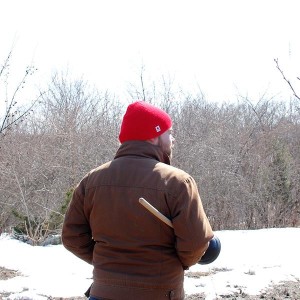 MARK: So, what’s next for Re Made?
MARK: So, what’s next for Re Made?
REBEKAH: Re Made is heading out of the virtual world.
MARK: So, are you telling me that I may have an opportunity in the near future to unclog my toilet with a documented, guaranteed aquatic tool hand-cast from fine silicone American rubber by fourth-generation plunger makers in North Carolina?
REBEKAH: Not unless you make one yourself, like the folks at the ZaneRay Group who took it upon themselves to make their own Re Made plungers. In some ways, this was the best extension of the work — instead of passively consuming a brand by buying into a company’s pre-packaged identity, people actively counter these messages by resisting consumption and participating in an act of resistance.
MARK: It’s worth noting that, up until now, if someone indicated that they wanted to purchase a Re Made plunger on your site, they’d just be forwarded to a hardware store. I’m curious to know if you’ve had any contact with said store… Has their plunger business taken off as a result of Re Made?
REBEKAH: I should check into that. You know, I haven’t had any contact with the Detroit Hardware Store. Linking to them was a way to present an alternative to my $350 plunger… and a nod to a local business.
MARK: So, what, if anything, have you learned from all this? How’s your life changed as a result of the Re Made Master Plunger?
REBEKAH: It would take a while to describe everything I’ve learned through the past nine months because there are so many components to my experience — the company, the artwork, the nature of humor and parody, language, imagery, the fascinating world of design blogs… I started out recreating a video and came to recognize a larger, complex cultural system and how I felt about it, which is informed by issues of gender and class. The project evolved through discoveries around authenticity and advertising and thinking about appropriation of working class identities for cultural tourism. Remaking the video turned out to be just an entry point for understanding how this world operates, for learning to identify categories of symbols, to be able to assess their jobs, and to recognize how the news media propagates these ideas under the guise of reportage.
…And I learned how to brand and paint a pretty good-looking plunger handle.


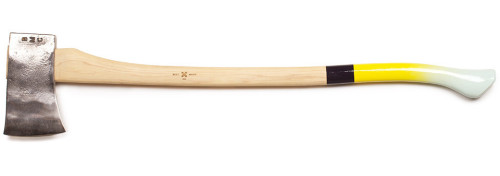

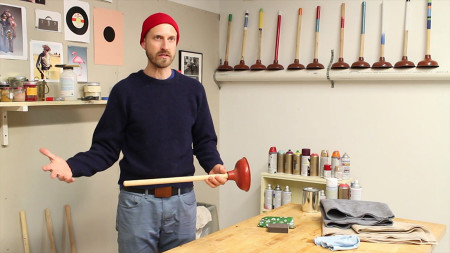
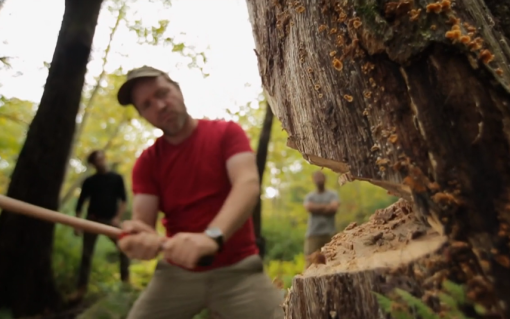
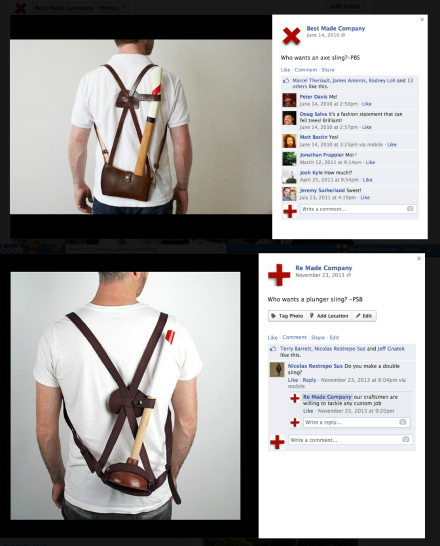











28 Comments
In his defense, $350 at the Prada store is like the dollar bin.
I find it hard to imagine that there’s a better target for such an attack. God bless you, Professor Modrak.
Peter BS, the designer behind Best Made, has done a lot of other stuff. Most notably, he collaborated with Maira Kalman on her edition of Strunk & White’s “The Elements of Style.” My guess is that he’s a smart, decent fellow who just saw an opportunity to take money from gullible people and took it. This doesn’t excuse him from criticism, however.
I REALLY WANT ONE OF THOSE PLUNGERS!
A couple of comments:
A quality axe is expensive. These axes are probably only marked up 20-35 percent. I would say it is overpriced but not a total ripoff–as they are being marketed in high end stores….
Chopping down trees with an axe is thrilling. Campfires are fun. I watched the video that Rebekah describes as porn-like. I have no idea what she is talking about.
The guys at Best Made probably really enjoy the process of campimg, campfires, and camp cooking. It sounds like they are trying to ritualize an experience they enjoy and are trying to market the tool as a way toward others having a similar experience. I don’t see what is so ridiculous about that….
I also don’t see what is so brilliant about this parody. The best made axe video is over the top. But, the plunger parody is to best made axes as tracing is to drawing. To each his own I guess…
The thing that I find interesting about this is that members of the art community find it so objectionable. It seems that the guys at best made have taken a page from the artists formula of how to be seen as interesting artist. That is, they have found something they like and have gone overboard in obsessing about it, it is this very same obsessiveness, often feigned obsessiveness, by artists, which often feels a lot less authentic to me, that is the artists bread and butter formula as they attempt to appear to be “interesting artists”.
My advice: chop a tree down with a quality axe, have a campfire, cook a meal, and then get back to us.
There is an axe-shaped void in the hearts of men. It can be filled for less than $400. The free market saves the day.
The markup is far greater with the axes with “designer” colors. The base axes are in the same price point as other well made axes. However, if you want a really useful axe for splitting wood, rather than felling trees, look here:
http://www.vipukirves.fi/english/
I’d also like to point out that the plunger selected for the parody is a sink plunger, not a toilet plunger. That has an extra flange to allow the plunger to extend into the toilet outlet to form the seal necessary for proper function.
This is the purpose of art, to facilitate these kinds of discussions.
I love all of this except the T-shirt thing. If I bought a pack of T-shirts and some artist had sewn them together, it wouldn’t make me think about anything other than the asshole that made me have to go back to the store and waste an hour exchanging the shirts.
This project makes me realize how many things I have seen that have been lifted from places, re contextualized and spun into commercial gold. The original project does this with the ax, but the response to it is what makes the distinction clear. The ax that hangs on a wall as a nod to work past is like the tractor in the front yard of a suburban lawn. It says, I don’t need to work, but I can claim the image of work for myself. The cult objects of the urban woodsman may be comforting to some who see a custom plaid shirt as grounding in the simpler life, but isn’t that what the Gap effectively did by turning the uniforms of the American worker into icons of first non conformity? If then, hard work is ultimately all absorbed by mass culture and commodity marketing, this plunger campaign works to un clog our thinking.
frosted flake, these men weren’t camping. They were on a photo shoot. This is to camping what porn is to sex.
Found myself calling a guy a douche axe just now under my breath.
Mr. X,
They are obviously not camping. This is not documentary footage, it is a highly distilled version of the experience of camping. Whether or not they like to camp and cut down trees for firewood as a hobby is another question. In terms of production style it has almost nothing in common with pornography. Maybe I am not watching the right porn. Much of what we see on film is not documenting a real event…Why argue there is something pornographic going on…Rebekah seems to strongly push the idea that there is something sexual happening….I find that to be a weird argument….I mean we get it, you are not interested in buying a quality axe, going camping. having a campfire….Why insinuate that the objects of your ridicule are closet broke back mountain gay necro-philes?
Also, I think my tracing/ drawing analogy was off the mark. It took skill to duplicate the look of the Best Made video.
Second vote that the porn metaphor being hammered home so hard (or should I say plunged deep into the reader, yuk yuk) quickly became tired, and took away from the message. Men doing “manly” things is always sexually aggressive, we get it.
Cue “ganging up,” retort.
For the record, there is plenty about the Best Made Co. to poke at, and I mostly like the actual work by Modrak. I just think the interpretation provided in the interview is either lazy or misandrist. I’d rather have heard more about the artist’s initial response to the plunger as a “beautiful sculptural object” and whether that response lends any validity to the BMC axes. If the value added by BMC basically amounts to shifting consumers’ perspectives to a place where they can appreciate otherwise familiar (or forgotten) tools as beautiful sculptural objects, is that so bad? Assuming BMC could make the argument that, in the interest of doing so, they identified an audience and created this work with this purpose in mind for that audience. Thus their work is akin to putting a very nice frame on a beautiful painting.
Also, is our distaste for the BMC product based mostly on an unwillingness to believe that they really love axes that much (as opposed to Modrak’s theory that they Really Love Their “Axes” that much), that they’re fakes who only care about money and don’t care about axes one bit? And if so, where do they lose us? That they’re young city-dwellers? That they have never really needed to use an axe because of their socio-economic whatever? To me, Modrak’s project transposed onto the Offerman Woodshop would seem mean-spirited, but I personally think Nick Offerman would be fun to hang out with, and I think he really likes woodworking. I, too, think the original video is full of douche, but I wonder if it’s worth checking a mirror to make sure our prejudice is neatly tucked under our bandannas before we go out.
Finally, is all of this supposed masturbation over basic homesteading skills (looking at you yarnbombers and backyard egg collectors) a product of the younger generations’ now innate sense that nothing about life in America can be relied on anymore? Is this the dance we do so that we can learn to fight?
Not sure I believe half of that, just wandering down a road there. Ultimately dot dot dash is right, so thanks to Rebekah and Mark for pushing me down the road this evening.
Speaking of axes and manliness.
http://imgur.com/Fgx0UuC
The tshirt shopdropping thing reminds me of the human centipede. I’d be totally freaked out if I were to get it. I’d think that someone had target me for human centipeding.
Lighten up! Parody is one of the highest forms of flattery, correct? Think of the number of presidents and dignitaries who have been made fun of over the years. Besides, if the axe makers are so ernest, they should take this in stride and move on with QUIET DIGNITY. I haven’t even thought about an axe lately, maybe I will invest in both. A new axe AND a new plunger! Thanks to you both!
Clinton visited Shinloa last weekend.
http://www.detroitnews.com/VideoNetwork/3510726600001/President-Bill-Clinton-visits-Shinola
I wonder how many BEHO dollars I could get for my shed full of third-generation axes… Probably substantially more than I would for a shed full of third-generation plungers!
Fuck this.
This project is the least inspiring thing on the internet.
Your crush on Peter is creepy.
http://www.salon.com/2014/04/13/david_foster_wallace_was_right_irony_is_ruining_our_culture/
This is great. I was wondering if anyone had done research on this faux manliness among high culture class men. Now I can read this fascinating research and the hypothesis.
For the longest time I was noticing the made in America/ pioneer nostalgia was taking a hold among men in highly metropolitan cities.
Rebekah, Montana thanks you.
I posted this somewhere else, but it belongs here:
Now this interview of mine has hit something called Neatorama and I have friends suggesting that I check it out, not knowing that I’m the one who did the original interview… Weird.
Unfortunate that this cynic is an “art” educator.
Well even fancy overpriced axes are potentially a useful tool… but for productive woodcutting nothing beats a chainsaw. Indeed the act of filling up the woodpile in the fall is often referred to as ‘chainsaw therapy’ in our household, and seems to fulfill a lot of the connection to outdoor real life with real work that must be missing in New York.
Looking on Google for a plunger share in Ypsi as I’m dealing with a serious problem right now. Found this instead.
People I was sharing an AirBnB with in Seoul plugged the toilet. In Korea, the shower and toilet share a common floor with no separation. Having tried without success to find a plunger anywhere in that city of 14+ million, I would GLADLY have paid $350 for a ReMade model.
Hell, I even tried music instrument stores looking for a Harmon mute.
5 Trackbacks
[…] My recent ‘axe vs. plunger’ discussion with artist Rebekah Modrak has made it to the popular website Design Observer thanks to an article by former New York Times Magazine columnist and author of Buying In: The Secret Dialogue Between What We Buy and Who We Are, Rob Walker. And, as often happens in cases like this, a whole new demographic is visiting the site. They’ll likely all be gone by tomorrow, but, if you could watch your language for the next 24 hours or so, I’d appreciate it. And it wouldn’t hurt if you could work in the occasional reference to Bauhaus typography, détournement, or kerning… Here’s a clip. […]
[…] If you like to read more about Modrak’s project, you can check out her interview in markmaynard.com […]
[…] by artist Rebekah Modrak, who, as you might recall, we’e talked with not too long ago about the marketing of perceived authenticity. The following clip from Modrak’s article, titled Bougie Crap: Art, Design and […]
[…] covers it… I do, however, like the idea that, in the spirit of successful new brands like Best Made, we could market the offices as having artisanal, Ypsilanti-aged, hand-planed wood floors. Maybe we […]
[…] nem szereti mindenki, és mert a Newton III. kimondja, hogy ellenerő ébred, ezért egy csodás művész, Rebekah Modrak elkészítette a Remade oldalt, ahol kézműves vécépumpákat lehet […]